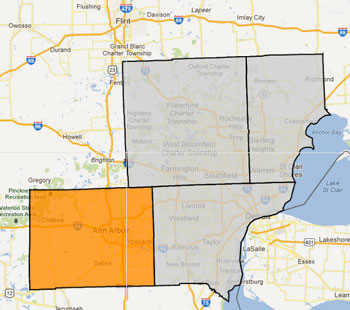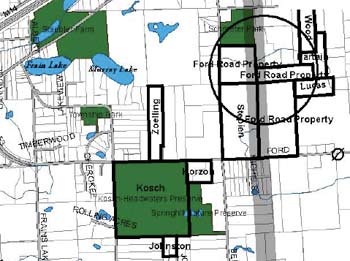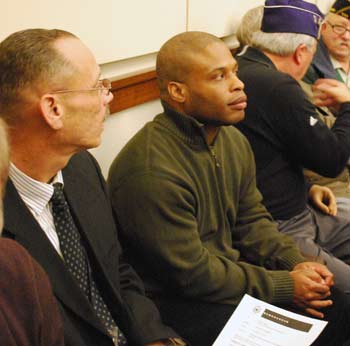Ann Arbor city council special meeting (Dec. 10, 2012): On a unanimous vote, the council passed a resolution objecting to the inclusion of Washtenaw County in a regional transit authority (RTA), created with a bill passed by the state legislature on Dec. 6.

The city of Detroit and counties of Wayne, Macomb, Oakland and Washtenaw are included in a regional transit authority created by state legislation passed on Dec. 6. The Ann Arbor city council wants Washtenaw County removed from the authority.
The language of the resolution was changed at the meeting to eliminate a request that Gov. Rick Snyder veto the legislation. Instead, the council substituted a request that the RTA legislation be amended to exclude Washtenaw County, where Ann Arbor is located.
However, the resolution retained other parts of its strong wording, including a reference to a provision about rail transportation – which calls the bill’s requirements for implementation of rail-based transportation “onerous and offensive.” It’s a clause in the legislation that requires a unanimous vote of the 9-member RTA board to “acquire, construct, operate, or maintain any form of rail passenger service within a public transit region.”
The RTA legislation specifically mentions “rolling rapid transit” – a system based on buses, not trains – as a possibility for four major new regional corridors: along Woodward, along Gratiot, from Pontiac to Mt. Clemens, and from Detroit to Ann Arbor. Supporters of the RTA with Washtenaw County’s current inclusion have claimed that a rail-based east-west commuter line between Ann Arbor and Detroit is still achievable, or even likely, despite the requirement of unanimous board support.
The council’s resolution reflected the fact that an east-west rail connection has been an aspiration of Ann Arbor mayor John Hieftje and other local officials for several years – demonstrated in a current study being done with federal funds to determine a locally preferred alternative for the location of a new Amtrak station. But the “onerous and offensive” clause in the resolution was subjected to debate, as some councilmembers supported its removal for completely different reasons.
Councilmembers who’ve opposed Ann Arbor’s continued study of a new rail station seemed to perceive the clause to be an implicit endorsement of continued investments in that direction. But Chuck Warpehoski (Ward 5), who could reasonably be described as the council’s strongest advocate for transit, argued also against the “onerous and offensive” clause. His argument was based on a belief that the legislation had a mechanism to allow the newly created RTA to implement rail-based services by creating yet another transit authority – thus circumventing the unanimous voting requirement. Ultimately, there were not sufficient votes on council to remove that clause.
Besides concern about the future of commuter rail, the council’s resolution indicates concern that the inclusion of Washtenaw County in the RTA would potentially risk the Ann Arbor Transportation Authority’s ability to continue its role to serve effectively as a transportation provider for Ann Arbor.
In the days leading up to the meeting, staffers with the Michigan Suburbs Alliance lobbied the council not to pass its resolution, in an effort that included a claim that the Ann Arbor city council’s resolution reflected a desire to determine unilaterally the county’s transportation future. In fact, the council’s action echoes the sentiments of a recent resolution approved by the Washtenaw County board. And a resolution of the Ann Arbor Transportation Authority board, approved in February 2012, supported the concept of an RTA, but conditioned that support on the coordination of new funding so that existing levels of transportation services provided by the AATA are maintained.
As of noon on Dec. 12, Snyder had not yet signed the legislation – it had not yet been presented to him for his signature, according to the governor’s office.
In this report, the council deliberations at its Dec. 10 special meeting are presented in detail. [Full Story]










